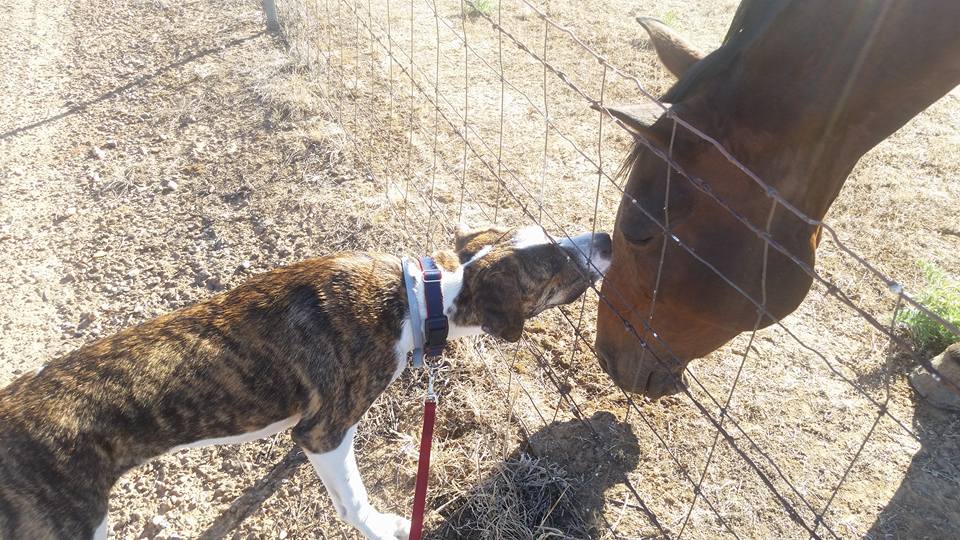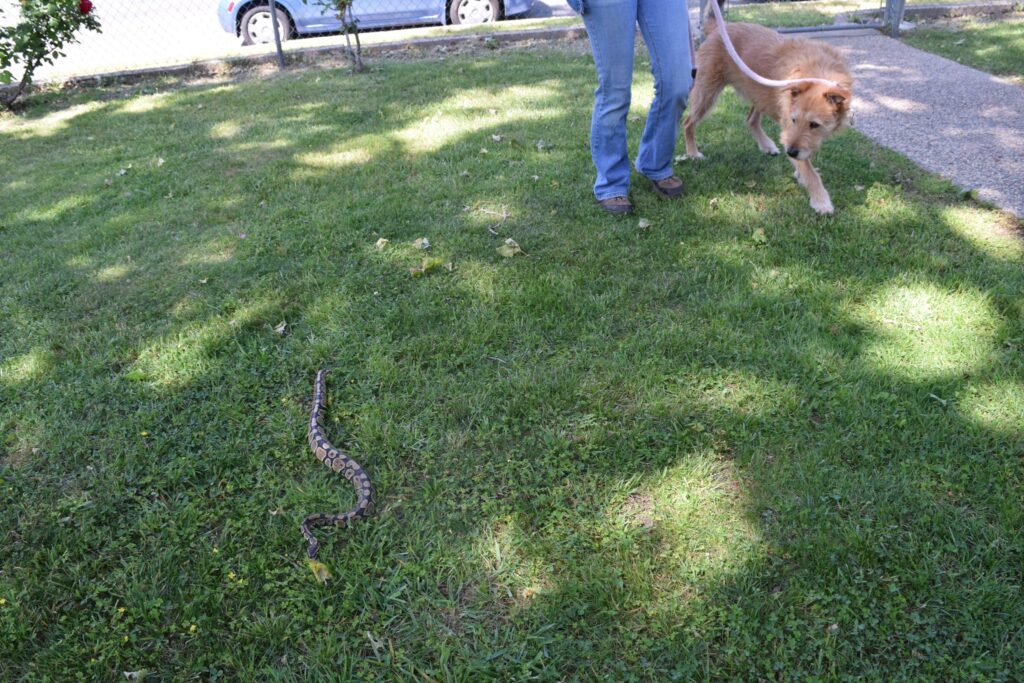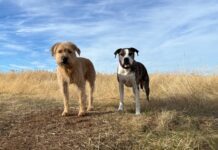
A reader commented on my most recent blog post (about my dog, Woody, coming face-to-face with the first rattlesnake we’ve seen this year). I mentioned that, in general, neither of my dogs is particularly predatory, and the reader asked how I knew that. It’s a good question!
Predatory behavior is natural and normal for dogs, and there are a number of ways it may be expressed. ALL dogs will exhibit some type and amount of predatory behavior but the type and intensity of the behavior that any given dog will express in different situations will depend on a number of factors, breed and the dog’s past experiences chief among them.
When dogs hunt for food, they may use a full “predatory sequence” of behaviors including (progressively, from spotting a prey animal to consuming it): eye (focusing eyesight on the animal); orient (moving toward the prey); stalk; chase; grab/bite; kill/bite; dissect; consume.
Humans have bred dogs in order to take advantage of certain aspects of this sequence. Herding breeds were developed to use the eye, orient, stalk, and chase phases of the predatory sequence – and to specifically exclude dogs who were predisposed to killing animals. Interestingly, some herding breeds who are used predominantly for working sheep (such as the Border Collie) have been developed to stop short of the grab/bite phase or the sequence, whereas breeds who are used predominantly for working cattle on the open range have been developed with more of a willingness to bite – but, of course, again without the temptation to go further than using a bite to convince stubborn or feisty cattle to turn and go where they are being directed. It’s amazing that by using individuals with these behavioral tendencies in a breeding program, the behavior of the majority of the progeny can be predicted along such a very fine slice.
Dogs who are used for hunting, whether for rats and other small vermin (such as many terrier breeds), birds (Labradors, setters, pointers, spaniels) or for lions (such as the Rhodesian Ridgeback), all have been developed by humans to display certain aspects of the predatory sequence.
According to his mixed-breed DNA-test results, Woody is about a third to a half Labrador. I feel that this inheritance accounts for a lot of his behavior. He is a fetching fool; if allowed to do so, he will fetch until he passes out. And when Woody is faced with an animal of a new species (or a new individual of a familiar species, such as chickens or horses) in a structured environment (on-leash, for example), he is friendly and curious. His tail wags and his eyes and body are soft. He doesn’t stiffen and gaze intently at the animal, or try to pull or lunge toward it; he acts a lot like he’s meeting a new person that he thinks he might like. His attention isn’t focused, laser-like, on the animal, but soft and wiggly.
There are a few exceptions, all of which arise in uncontrolled circumstances. If he’s in the yard, and there is a squirrel or a strange cat within view, he will chase it. I think most dogs will do this, more from the fun of the chase than a desire to kill, although, of course, we can’t know what’s in a dog’s brain. If we’re walking off-leash somewhere, and he spots a jackrabbit or a deer – both of which he’s chased a couple of times without heeding my cues for “OFF!” or “HERE!” – he absolutely will at least start to run after them. He’s gotten way better about resisting that temptation, though the success of my recall and cue to “leave it” will depend on how far we’ve already hiked (if he’s already tired, he’s less likely to give chase), whether it’s super hot outside (if it’s blazing hot, he is less likely to give chase), and how close he was to the animal when he spotted it (if it was super close, it’s going to be very tempting to chase).
However, if he were to meet a cat or tame rabbit, squirrel, or deer when he’s on a leash, I know for a fact that he’d be friendly. His desire to chase is all about the fun of the chase.
Here’s a better indication that he’s not very predatory. He once dug up a vole (a mole-like creature) on our property; he LOVES to dig up their tunnels, although it’s clear from this incident that he has no clue WHY he’s digging or WHAT he’s digging for. He is highly attracted to the smell of the animals in the tunnels underground, and will deeply huff the hole and then dig furiously. One day, as I was walking around my property doing various chores, I saw him out in my field digging. A minute later, I looked again and saw him do the same sort of behavior I recently witnessed with the snake: He looked down at his feet, and then slowly swiveled his head and looked deliberately at me, and then slowly looked down again. The look was, “Mom, I’ve got something…but I don’t know what!”
Afraid it was a snake, I ran over to him, yelling “Off!” He obediently took a step backward as I ran toward him – and as I arrived I could see a stunned-looking little vole, laying on its back, with its feet still moving. I think he actually dug it out of the ground with his furious digging; I don’t think he had grabbed it, because it wasn’t wet or bitten. He was plainly mystified by its very presence – strongly drawn to it, but not sure what to do.
I’ll tell you who was certain what to do: my senior dog, Otto, who arrived on the scene a few seconds after I did. Otto took one look at the vole on the ground and immediately grabbed it and shook it. Boom: dead vole. And was he ever proud! “Ha!” he seemed to say. “That’s what you do with that, ya idiot.” Both Woody and I were shocked!
Some months later, I saw that same “Mom, this is weird! Come look!” expression on Woody’s face. When I went to investigate, I found him standing over what I think is a dead baby gopher. Since my property is PLAGUED by these voles and gophers, I celebrated this development at the time, but this was actually the last recorded death of a rodent here. And, to tell you the truth, I don’t know that Woody even was the one who killed it; it didn’t have a wound on it, and it was completely wet and covered with saliva, like he had been licking it. For all I know, he dug up a baby, licked it incessantly, and then it died of exposure from being wet and cold!
Different animals may provoke a different predatory response. Otto came from a shelter with a “rap sheet” of having killed someone’s chickens as a stray adolescent dog, but I was very easily able to dissuade him from his interest in my own chickens, with some simple lessons in “Leave it.” (You can see both his interest, and his willingness to “leave it” in this video I took a couple years ago, when my current chickens were new baby chicks. Look at Woody’s response, as a contrast. His interest seemed very maternal. He wanted to clean the baby chickens’ tiny butts! “But Mom! They need a mother!”)
But even though Otto seemed to know without any hesitation whatsoever how to kill a little rodent, and, indeed, had the strong instinct to do so, he’s never shown the slightest impulse to chase after or grab lizards or snakes. And some dogs definitely do! I have one friend whose dog had, over her lifetime, grabbed and dispatched at least three garter snakes (to her owner’s dismay; garter snakes are both harmless to dogs and a great asset in killing moles, gophers, and voles who destroy home gardens). Perhaps these are behaviors that are also learned, because my friend’s other dog, who came along when snake-killing dog was about four years old, would go nuts if she saw a lizard. If a lizard ran under a planter box or into the crevices of a rock wall, woe to the planter box or rock wall; she would tear them apart trying to get at the lizard.
Over the years, I have witnessed Otto’s lack of interest in the snakes we’ve seen on the trail, but the best evidence of this was when, years ago, I used him as a model for an article we did about snake avoidance training for dogs, and I used a friend’s pet snake as a co-model. The problem on that shoot was trying to get Otto to look at all interested in the snake (so that we could show how to teach him to “leave it” alone). His response ranged from “So what?” to “Can I go now?” He wasn’t afraid or interested. It was like trying to get him to work with rocks.

In contrast, when, in each of the three instances he’s seen a rattlesnake on the trail, Woody has given me that same, “Mom? What’s this?” sort of look, and has moved away from the snake either by himself, or easily in response to my “Off!” cue. So I’m not terribly worried when walking either of my dogs off-leash in snake country, although I stay very alert at this time of year and scrupulously watch their reactions to everything they see. In the winter, I can space out a little while we walk; not so at snake times and in snake places.
For more about predatory dogs, and dealing with predatory behaviors, see https://qa.whole-dog-journal.com/behavior/understanding-highly-predatory-dogs/.
Is your dog interested in some animals more than others?






I have an older Presa female – her animal prey drive is HUGE but she tends to assess the situation – if it’s a horse (especially an aggressive stallion or a crabby, pregnant mare 😉 she will quickly identify her own place in the hierarchy and act accordingly. Small children (under 2 years old) are completely off-limits for any sort of interaction, as I can tell from her stance that she doesn’t know what they are. She came to me as an older, (not vicious) unsocialized rescue so it was a bit of a challenge training her to safely interact with other animals. She has learned to play with other dogs, though I only allow one-on-one play and always with a dog of relative same size or larger (hard to find Larger, alas).
My last Airedale terrier Eloise had fear aggression, until I learned to turn the other dog’s butt around so she’d know the dog wasn’t going to hurt her. With that sniff, I’d watch her body relax.
However, she did kill 2 animals. When I took her and my older male to a winter farm field for a run, my older Airedale a champion in obedience, turned around to go home which upset our whole walk. I knew my gentle Chaucer would be fine but I was worried about Eloise and proceeded to climb over snow banks in backyards trying to reach her. Then I saw her grab something black and proceed proudly up our street to our house. I thought, Oh no, someone’s cat! She set it in front of our door and marched happily down the driveway to greet me and show me “our dinner.” It was a dead skunk. And I had to meet my husband in a restaurant in 20 minutes. Thank god for Skunk Off! Had to throw her collar out but she was neutralized.
But another hunt was more disturbing because the victim was probably a pet. We were hiking in deep woods when I saw Eloise grab a cat under low brambles by a stream. Unable to reach her, I kept yelling, Leave it! She took it into the stream and drowned it. I had to come to respect her skills…we didn’t need the meat but in another era?… and my own lack of them so I kept Ellie on leash after that sadly. So difficult to see those two deaths caused by My dog. Last time I got a dog from a new breeder.
It’s irresponsible to blame any breeder for your dogs behavior when it would appear dog lacked sufficient training.
Owners are responsible for their pets behavior.
I currently have a Plott mix with an insatiable prey drive. We live in the country and he has dispatched several snakes including at least one copperhead. He has killed several toads but has apparently since figured out that they don’t taste very good and are therefore not worth the trouble. He reacts to the neighbor’s cows and horses, any “critter” in “his” territory such as cats, other dogs, opossums, skunks, squirrels, armadillos… you name it.
Off-leash walks are now only a distant memory from the time I had Labrador Retrievers, but he is (mostly) manageable on-leash.
Regarding snakes, we have a lot of them in SW Florida! My GSD old girl will chase harmless snakes such as black racers but will point poisonous snakes. That was fortunate for me as she pointed a large moccasin near the house which I didn’t see and would have stepped on. She continued to point it until I went in the house and got my snake shot pistol. She will also point ground (pygmy) rattlers which are quite numerous in our rural area and very hard to see. My 9 month old GSD and I nearly stepped on a large diamondback rattler on one of our walks along the roadside. I saw it just as she was about it step on it and pulled her away. She never smelled or saw it and I thought it might be dead but we walked by the spot a few minutes later and it was gone, obviously not dead, just taking a break.
Diana pawPrints has luckily never met a snake but we have rattlers in the area and there is a protected canyon along our walking route. I always walk her on leash as when she gets going no come or leave it is going to stop her. She is German Shepherd/ Golden Retriever/ many Mutts but won’t fetch. She loves people when we are out and about. The dog park is the people park to her as she must go and greet everyone. But in the front yard if anyone passes by the fence she barks up a storm of warning. She hates cats, birds and any mouse in the yard. I am sure if she caught a cat she’d kill it. She’s already killed several mice and a bird she caught. Feral cats used to come in the yard when she was a puppy and I’m sure they did something to her to instill the hate. She used to be just curious but that changed. I’m also sure the German Shepherd is giving her that prey drive and the Golden Retriever is instilling that love of people. The Mutt Mix is likely to blame for her lack of fetching. She’ll chase balls but she won’t bring them back.
Informative! My previous small dog, a Maltese or Maltese mix, had absolutely zero prey drive. My current small dog, a Maltese poodle, has enormous prey (or maybe just pursuit) drive for squirrels, chipmunks, and even small birds. Rodents and rabbits, not so much. A few snake encounters, very minimal interest. So interesting how this all plays out. Thanks much.
My present dog – 8 year old rescue (lab-mix?) was I believe a city dog. So the deer really fascinate him. We walk thru our field & near the woods so in the colder months see many deer. I doubt he EVER saw one before or walked anywhere not on a leash. Since I live on a secondary road AND there are many idiot drivers – the leash or cable continues. He is somewhat learning that the “babies” are not to be chased, but if he was off the leash – not sure if he has an off or leave it button – not willing to chance it either. Hes a wonderful dog – very lovey & sweet – would love to be able to have him loose, but not willing to take a chance on losing him. I had 2 chocolate lab mixes over a period of years & they didnt run loose either. Needless to say – loose dogs running deer (or running in the woods) get shot!
We had a cocker spaniel who loved to dig for mice when we were out camping in a naturalized field setting. Not sure if she ever killed any. She was a rescue and before we got her spent most of her days outside in a kennel, probably watching the wildlife come and go in her country setting. Another episode was her and our other spaniel, doing a tag with a mouse between our RV dual wheel tires. Another cocker spaniel killed a bird that was flying too close to him in our back yard, one chomp.
My white boxer, Broedy was a gentle giant. I was in the park with him and several dogs one evening when a tiny mouse ran out from the grasses right under his paws. There was no way I could get there in time to stop him killing it so all of us gasped and held our breath to see what he would do. With total gentleness he nudged the mouse back into the grass while we all stood stunned. Another time we were walking at night in the late fall and he stopped at a bush. When I tugged on his leash to move on he refused so I went over to see what had caught his attention. It was a Budgie! I thought it was dead, but it moved and I realized it was probably cold stunned as it was chilly. So I picked him up and took him home. We called him George and had him for five wonderful years!
My half border collie+1/4 Pyr+1/4 unknown is large & strong & fast. I am too old (can’t move quickly enough) to train him to herd my sheep but have several times had him “help me” by his eye and making my directions seem more serious to my sheep as we “walked” a group of sheep from one place to another. In early Feb, tho, I thought we were working successfully when my dog’s excitement caused him to jerk the leash out of my hand (breaking my right index finger). Free, he chased a ewe and got her down but thankfully didn’t bite her. I rescued the sheep by recovering the leash first, tying the dog, putting my finger somewhat back in place, then putting the ewe back with the rest where they needed to be, and then going to dr. My dog has some ability which is being wasted, but it is beyond my ability. I feel sure readers will be critical of me, but if there are any HELPFUL suggestions, I’d love to read them.